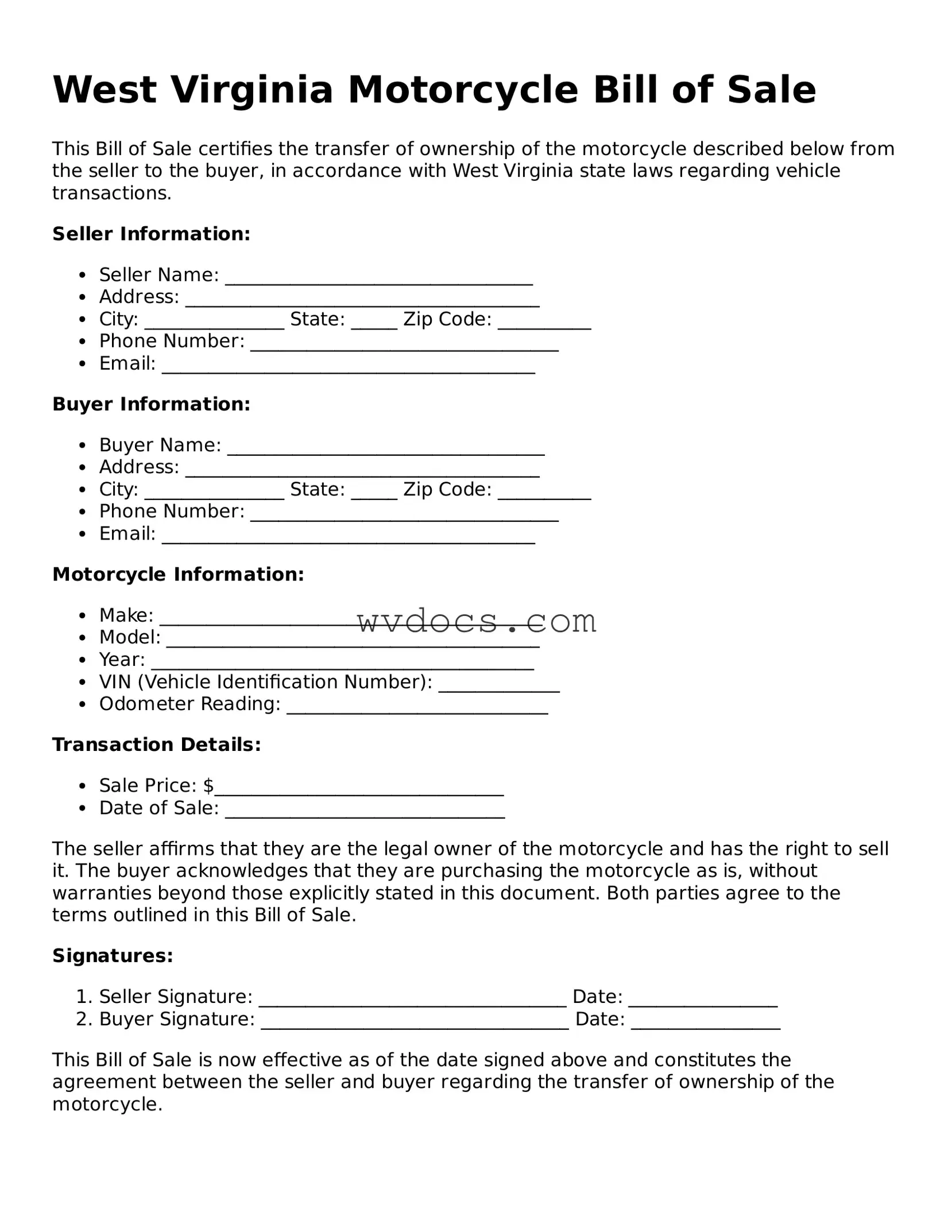The West Virginia Vehicle Bill of Sale is similar to the Motorcycle Bill of Sale in that both documents serve as proof of transfer of ownership for a vehicle. Each form includes details about the seller, buyer, and the vehicle being sold. The Vehicle Bill of Sale may also include information about the vehicle's identification number (VIN), make, model, and year, just like the Motorcycle Bill of Sale. This document is crucial for registering the vehicle with the state after the sale.
The West Virginia Boat Bill of Sale shares similarities with the Motorcycle Bill of Sale, as both documents are used to record the sale of a recreational vehicle. Each form captures essential details about the buyer and seller, as well as specifics about the boat or motorcycle, such as the hull identification number or VIN. Both documents help establish legal ownership and can be used for registration purposes.
The West Virginia ATV Bill of Sale is another document that closely resembles the Motorcycle Bill of Sale. Both forms are designed to facilitate the transfer of ownership for off-road vehicles. They include similar information, such as the names of the buyer and seller, vehicle identification numbers, and purchase prices. This ensures a clear record of the transaction and assists with registration and title transfer.
The West Virginia Trailer Bill of Sale is akin to the Motorcycle Bill of Sale, as it also documents the sale of a vehicle. Both forms require details about the seller, buyer, and the vehicle in question. The Trailer Bill of Sale may include specifics like the trailer’s VIN and dimensions, paralleling the information required in the Motorcycle Bill of Sale. This document is essential for establishing ownership and for registering the trailer with the state.
The West Virginia Snowmobile Bill of Sale is another document that aligns with the Motorcycle Bill of Sale. Both forms serve to record the sale and transfer of ownership of recreational vehicles. Each document contains information about the buyer and seller, as well as the vehicle details, such as VIN and model. This ensures that ownership is clearly established and can be used for registration and title purposes.
The West Virginia Firearm Bill of Sale has some similarities with the Motorcycle Bill of Sale, as both documents are used to record the transfer of ownership of personal property. Each form includes the names of the buyer and seller, as well as a description of the item being sold. While the specifics differ, both documents serve as proof of the transaction and can be important for legal purposes.
The West Virginia Personal Property Bill of Sale is comparable to the Motorcycle Bill of Sale in that both are used to document the sale of personal items. They contain similar information, including the names of the buyer and seller and a description of the item sold. This document serves as a receipt for the transaction and may be necessary for tax purposes or to establish ownership.
The West Virginia Business Bill of Sale resembles the Motorcycle Bill of Sale in that it documents the sale of a business or business assets. Both forms require details about the seller and buyer, as well as a description of the assets being sold. This document is vital for establishing legal ownership and for any future transactions related to the business.
For those navigating the intricacies of vehicle ownership transfer, understanding the West Virginia Vehicle Bill of Sale and its counterparts, such as the Motorcycle Bill of Sale and others, can make a significant difference in the transaction process. Each document serves as an essential safeguard to ensure clarity and legal standing, thereby contributing to seamless ownership transfers. For additional resources related to legal agreements, you can visit arizonapdf.com/, where further information is available.
Lastly, the West Virginia Lease Agreement can be seen as similar to the Motorcycle Bill of Sale in that both documents involve the transfer of rights related to property. While the Lease Agreement is about renting rather than selling, both documents include the parties involved and specific details about the property. They both serve to clarify the terms of the agreement and protect the interests of all parties involved.
